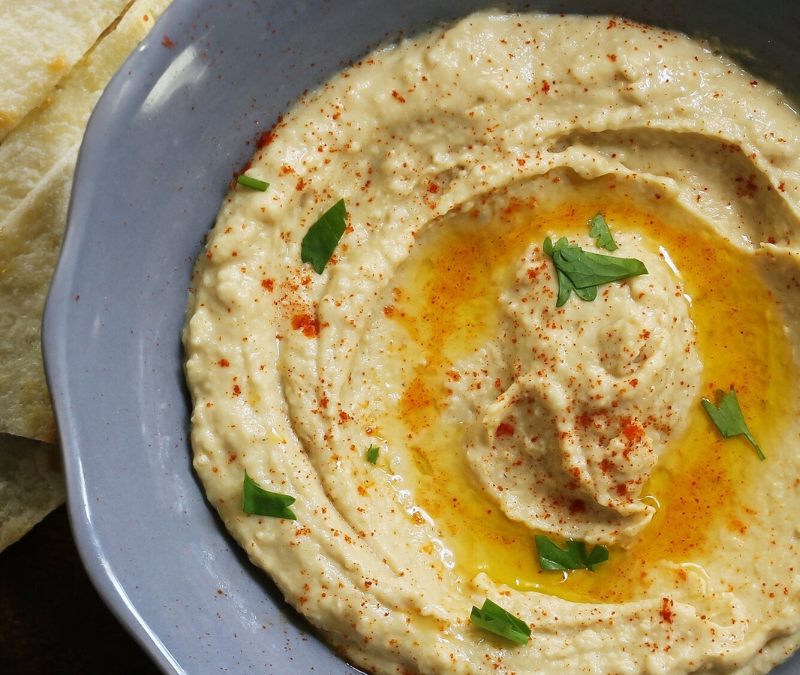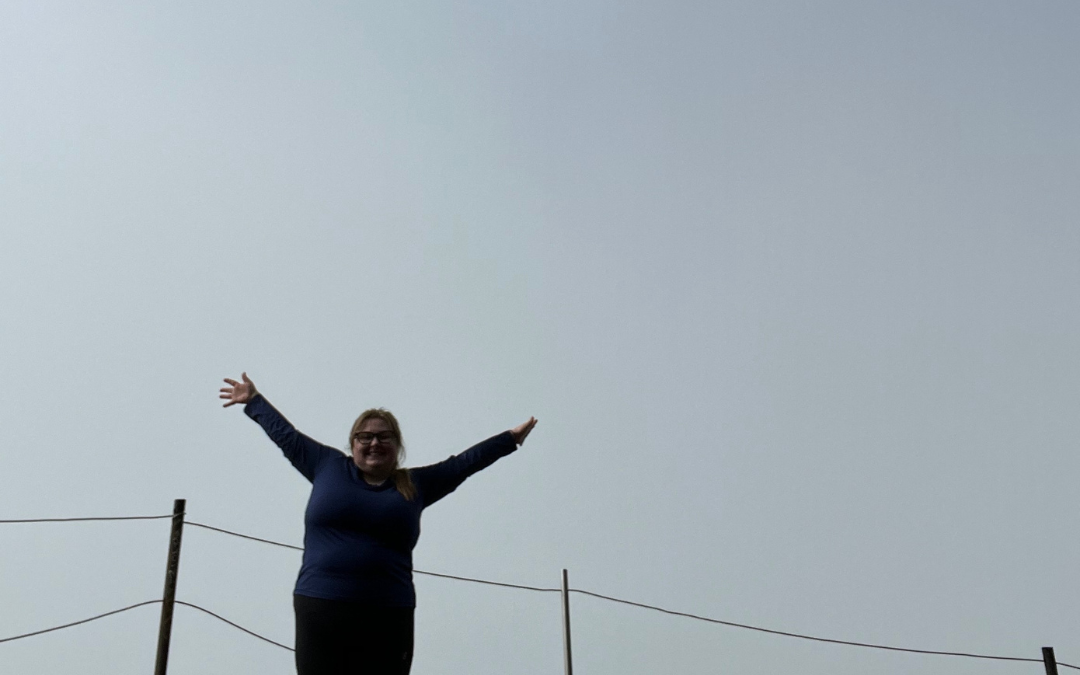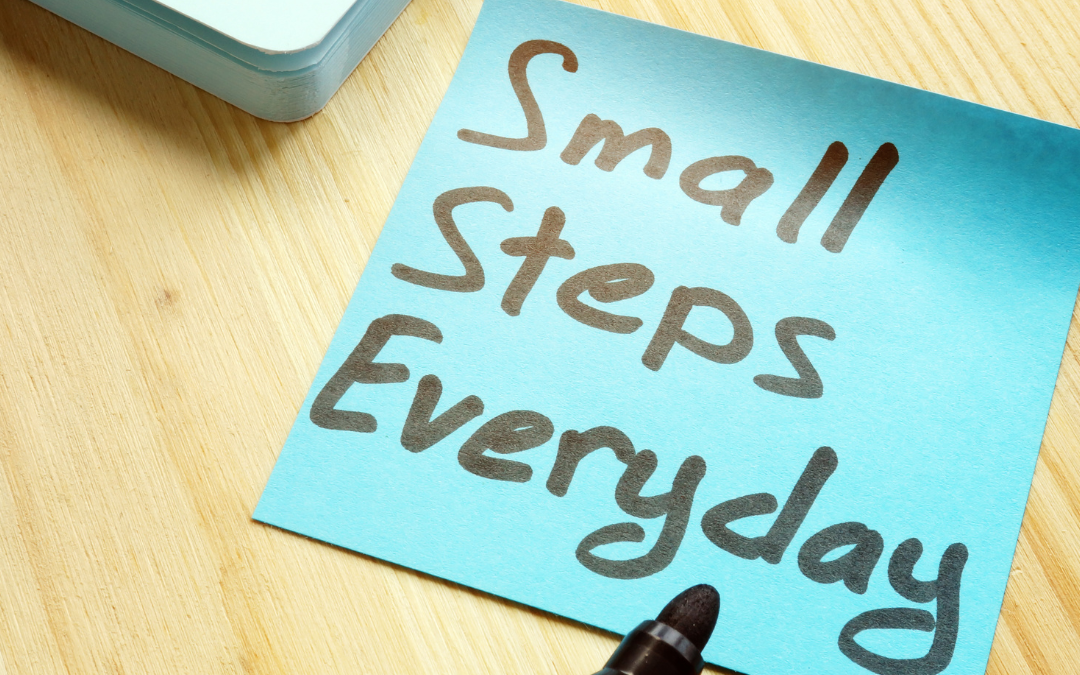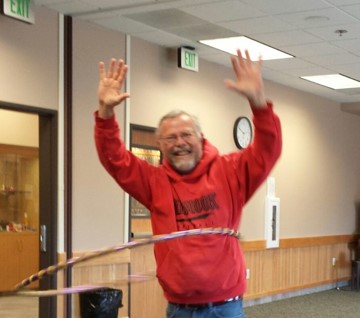
by Guest | May 9, 2024 | Eat Well, Featured, Lunch & Snack Recipes, Recipes
Creamy homemade hummus —a classic Mediterranean dip perfect for sharing.
- 15 ounce can chickpeas/garbanzo, rinsed and drained well
- juice from 1 lemon about 1/4 cup
- 3/4 teaspoon kosher or sea salt
- 1-2 cloves garlic very finely minced
- 1/4 cup plain yogurt
- 3 tablespoons extra virgin olive oil plus more for drizzling
- 1/4 teaspoon smoked paprika
- minced fresh parsley
-
In a food processor, combine the chickpeas, lemon juice, salt, garlic and yogurt. Process for 1 minute, then open the food processer and scrape the sides. Process for another minute.
-
While the processor is running, pour in the olive oil. Taste and check for smooth consistency.
-
If the hummus is too thick, add 1 tablespoon of water.
-
Just before serving, sprinkle with smoked paprika, fresh parsley and drizzle with additional olive oil.
- Enjoy on pita bread, fresh vegetables like carrots and cucumbers, or as a spread in sandwiches and wraps!
Resource: steamykitchen.com

by Guest | Apr 24, 2024 | Being Well, Featured, Uncategorized, Why I'm In
“WHY I’M IN …” An interview with Emery Edwards, AmeriCorps, VISTA
What drew you/your organization to partner with Tillamook County Wellness?
I’ll be honest, I started working with TCW because it was something required of my position as an AmeriCorps VISTA volunteer. I came to Tillamook, though, because I was in search of something more fulfilling, authentic, and close to nature than what I had built in Seattle. Since the first day I learned about TCW I was inspired by the community-driven initiatives to make Tillamook a better place to work, live, and be. I will continue my work with TCW because I am inspired by the passion exhibited by its members towards the never-ending work of improving this county. I have found that TCW embodies what I was searching for when I moved to Tillamook- it is authentic, innovative, fulfilling, and emphasizes genuine relationships and community action.
What, if any, changes have you seen come about as a result of this work?
I can see how TCW brings organizations and people together for initiatives to improve the county. Being behind the scenes and involved in several committees I have the unique opportunity to see so much of what TCW is doing! The collaborative nature of the committees creates buy-in throughout organizations in the county and provides a platform for the exchange of ideas all towards the betterment of our community. I specifically see how a lot of what TCW does is directly informed by data collected about the greatest needs of the county, specifically for vulnerable populations. I see access to care and access to physical activity being increased for all of Tillamook County, but particularly emphasized for historically underserved populations. This is critical work that is not being done everywhere and I’m so happy that TCW is taking that initiative.
What have you learned from being involved in this work?
Gosh, I have learned so much about what it means to bring about community action. This community has so many wonderful members who are passionate about improving the livelihoods of all county residents which has restored some of my faith in humanity. I learn so much from my work with TCW almost every day, but I think the biggest thing I’ve learned is that community action like TCW is even possible!
What are your hopes for this work as it relates to you/your organization?
I hope that this work can continue to grow and expand to include more representatives of the community. I really hope to see more community members, retirees, and other people looking to use their time, energy, and skills to better their community through TCW. I hope that this will cultivate a sense of ownership for Tillamook County residents. In my experience, if you yourself work on something you feel a sense of ownership over it. And that’s really important for this program’s sustainability. The more people come together wanting to improve their community through TCW the more positive impact we’ll be able to make
What are your hopes for this work as it relates to changing community health in Tillamook County.
Moving to Tillamook County has changed my life, and I know it can change so many others. I really hope that this work will improve access to a happy and healthy life for all. It’s really hard to not have any healthy habits, nutritional knowledge, or a healthy relationship with your body. I believe that TCW is providing access to healthy choices we can make for ourselves. This is essential work to improving community health because when you feel like you’re on your own with your health, it’s really isolating and it can feel like you have to reinvent the wheel. TCW is changing Tillamook County for the better, and my biggest hope is that we continue to receive support from the community we serve.
Is there anything else you’d like to share?
I would just like to add that moving to Tillamook County has changed my life for the better! I’ve been able to build a wonderful community of authentic, caring, amazing people who truly care about this community. Tillamook County has its flaws but it is such a special place to me and I am so grateful to have had the opportunity to serve here. I am so looking forward to seeing what amazing things we can accomplish with community action! And, a special thank-you to Michelle Jenck, the Tillamook County Wellness Coordinator. Without her, so much of this work would not be possible!

by Michelle | Jan 25, 2024 | Being Well, Featured, Move Well, Uncategorized, Work Well
Intro to Behavior Change, Part 1
Every day we hear the results of another study, telling us what is making us unhealthy. Eat this, don’t eat that. Move like this, not like that. There are, of course, good reasons to become educated about making healthier choices. We are on an unsustainable track both for our own health and for the economic health of our nation. In all reality, our health care crisis – the skyrocketing cost to treat preventable, chronic disease – is a greater threat to our survival than global climate change. As with all things, though, we have made the solution far too complicated for the average person to comprehend.
Let’s get down to the fundamentals. First, we simply have to become more aware of our own habits. How do I feel when I eat this and don’t eat that? How do I feel when I walk up a flight of stairs? How much energy do I have? If the answers to these questions are not the ones you’d like, then it is probably time to start making some changes.
Change is hard. Crazy hard. It’s really inconvenient. That’s how we got into this mess in the first place. It is human nature to take the path of least resistance. It takes time and effort to change the way we live our lives. For most of us, this is where we end up – in a state of knowing we need to do something but not believing that we can really do anything about it. To be successful, we need to make the changes to our habits small, easy-to-adopt, and enjoyable.
Behavior Change 101, Part 2
Awareness. This is where it all starts. We have to stop and look within ourselves to even begin to understand what is and isn’t working. This goes for health and nutrition but also for relationships, self-esteem, work performance, you name it. What is the famous saying? The first step is admitting you have a problem.
You don’t have to become a Yogi (yoga instructor, not the bear) to become aware. You don’t have to take special classes (although that might help). You don’t have to change the kind of person you are (although you probably will in the end). You just need to be open to the idea of changing.
We see things more clearly when we take a step back and give them our undivided attention. Take a few moments each day to breathe. Just be. Relax. In doing so, the busyness of the world, the noise of our self-talk, the daily to do list, they all disappear and we are simply left with ourselves and the truth. Layers of thought, emotion, and even traumatic events are often responsible for the “dis-ease” that causes disease. Without going through this process, it may not matter what changes we make to our nutrition or exercise habits. Our bodies seek balance. This applies to our emotional state as well. When we are out of balance, there are a whole host of physiological processes that go off-line as well.
Unfortunately, the typical American lifestyle does not lend itself to mind-body balance. It can seem overwhelming to understand what is out of balance and what we need to do about it. This is where awareness is key. At some point, most of us have tried to determine how many calories, grams of protein, fats or carbohydrates or how many minutes of high or low intensity exercise we should be getting each day. And, statistics show that this hasn’t worked out so well for most of us . . . at all.
So, how do we identify and make the changes we need to make? Pay attention to your own body and mind. What you think and feel, what you read, and what you hear others say all provide clues if you are tuned in. Listen to that voice in your head, that gut instinct that kicks in and says, “Hey, that’s what I need to do. I can do that.” I call it the When-Harry-Met-Sally-Moment – “I’ll have what she’s having.” Pay attention to what inspires you and follow that thread.
Tips for Successful Behavior Change, Part 3
Why we want to make changes is almost as important as what we want to change. The “why” often determines our chances for success. If we are making a change for our spouse or boss, or as a quick fix (think high school reunion), we might not be as emotionally invested as we need to be successful over the long term. You need to have good reasons to make any lasting change. Maybe it is to be around to see your kids or grandkids grow up or maybe it is about improving your quality of life. Whatever it is, it needs to be meaningful to you.
Setting SMART goals is key to successful behavior change. SMART is an acronym for research-based characteristics that significantly increase the likelihood of reaching one’s goals. They should be:
- Specific
- Measurable
- Attainable
- Relevant
- Time-Bound
For example, if I want to walk 2 miles a day but am currently completely sedentary, I need to break down my goal into manageable pieces. I also need to be realistic. How far can I, and more importantly, will I, walk each day. Maybe it is just a daily walk to my mailbox for the first week. Then, I can walk to the end of the block, then 3 blocks, and so on until I have achieved my goal. It is important to set a time frame for each level of goal attainment. This can be daily or weekly. It needs to be short enough to generate immediate success but also long enough to form a new habit as a foundation for the next step and that usually takes about 8-10 weeks.
Work with your strengths and interests when approaching changes. If you like to cook, then it makes sense to find healthy recipes you would enjoy making. If you hate cooking, it will be important to simplify what nutrition changes you are making so that you can still be successful. It can be as simple as choosing the prepared veggie tray and a container of hummus from the grocery store. This principle is especially important when it comes to physical activity. If you enjoy being outdoors, consider walking or hiking. If you like people, music or dancing, you could join a group fitness class. If you want something more mindful, try Tai Chi, Qigong or Yoga. The key is to look for ways to integrate a positive, healthy change with your personality, interests and strengths.
One of the reasons people struggle with behavior change is because they have been unsuccessful in the past. Three common reasons for this are 1) Setting unrealistic goals 2) Giving up after the first setback, or 3) Taking on too many changes at once.
To avoid these, it is important to set a narrow list of ridiculously small goals. This allows us to celebrate mini victories which perpetuate future successes. BJ Fogg, a researcher at Stanford University, calls these “Tiny Habits.” He uses an example for someone who wants to develop the habit of flossing their teeth. He suggests flossing one tooth each night after brushing your teeth. Just one tooth. This is based on the fact that a 3 second action of flossing one tooth is perceived as much more doable than the 30 second action of flossing all of our teeth and, therefore, we are more likely to stick with and succeed at the development of this new habit. As sad as this example is, he is 100% right (and he has the research to back that up.) This says a lot about human nature and explains a lot when it comes to why behavior change is so difficult.
To summarize, there are some tricks to successful behavior change:
- Become aware of what you want to change and why
- Set SMART goals
- Make changes that fit your personality, strengths and values
- Start small (REALLY small) and build on your successes
Written by Michelle Jenck, M.Ed., Certified Behavior Change Coach
For more local health and wellness information, visit www.tillamookcountywellness.org or follow Tillamook County Wellness on Facebook and Instagram.

by Guest | Jan 4, 2021 | Being Well
In 2014, Bill Baertlein, local accountant and civic leader, began floating an idea to do something fun to get people moving in a healthier direction. It didn’t take long for that simple concept to become a county-wide initiative, now known as Tillamook County Wellness (TCW). As Bill Baertlein ends his service as County Commissioner, we celebrate how he has helped Tillamook County become a healthier place to live, work, and play.
Bill launched the 2016 Year of Wellness with a rallying cry of “YOW!” and an impressive display of hula-hooping. He even challenged other County Commissioners in the state to follow suit; something many of them did but with a bit less flare. During that first year, 900 people participated in the team based “YOW Challenge” to make small changes to their daily health habits. Suddenly eating a few more vegetables or walking a few more minutes each day wasn’t work but something fun we could all do together. That was, and still is, Bill’s vision, who always said, “It has to be fun! If it becomes a fun-sucker, no one will want to do it.” And, boy was he right. Bill’s leadership and commitment to a positive and innovative approach to improving population health make him the Wow of YOW.
Tillamook County is known for being a tight-knit community, where people and organizations work together to get things done. YOW presented a purpose-driven opportunity to work together to tackle the big challenge of chronic disease, especially type 2 diabetes. Thanks to strong political will and the financial backbone of Tillamook County Community Health Center (no county tax funding supports this work), Tillamook County Wellness has exceeded everyone’s expectations. As of 2020, Tillamook County is ranked 10th healthiest county in Oregon, a steep rise from 26th place in 2015.
The TCW framework is designed to not only help individuals with their daily choices but, most importantly, to serve as a hub for collaborative solutions that help make the healthier choices the easier choices for everyone. By pooling resources and working together strategically to strengthen existing work, we are building vital relationships and a shared understanding of what it takes to help all people thrive. Some examples include:
- Tobacco-free spaces
- Community and workplace-based health screenings
- Mobile health and dental care
- Web-based platform for community resource referrals – coming soon!
- Detailed, web-based maps of all county trails and outdoor recreation facilities – coming soon!
- Volunteer led walking groups
- Workplace wellness activities
- Food box deliveries
- Lifestyle coaching through National Diabetes Prevention Program (DPP)
- Information hub for getting connected to fitness, cooking, gardening, volunteering and more at www.tillamookcountywellness.org
This work only works because of the commitment and support of leaders like Bill Baertlein. As he steps down, he passes the baton to Mary Faith Bell, who will be the new Commissioner liaison for Tillamook County Wellness. We welcome Commissioner Bell and are excited to bring her experience and passions to this work.
As we enter a new year, we hope you will consider ways you can support your own health as well as that of your family, friends and co-workers. Taking small steps that are easy and fun (and definitely not fun-sucking!) are the key to better well-being. For more local health and wellness information, follow Tillamook County Wellness on Facebook, Instagram and Twitter.
Tillamook County Wellness relies on community involvement. If you are interested in donating your time, treasure or talents, please contact us at info@tillamookcountywellness.org or (503)815-2285.
AUTHOR: Michelle Jenck, Adventist Health Director of Community Well-Being
Tillamook County Wellness is a program of Tillamook County Public Health. Through a partnership agreement, coordination of Tillamook County Wellness is funded by Adventist Health Tillamook.




